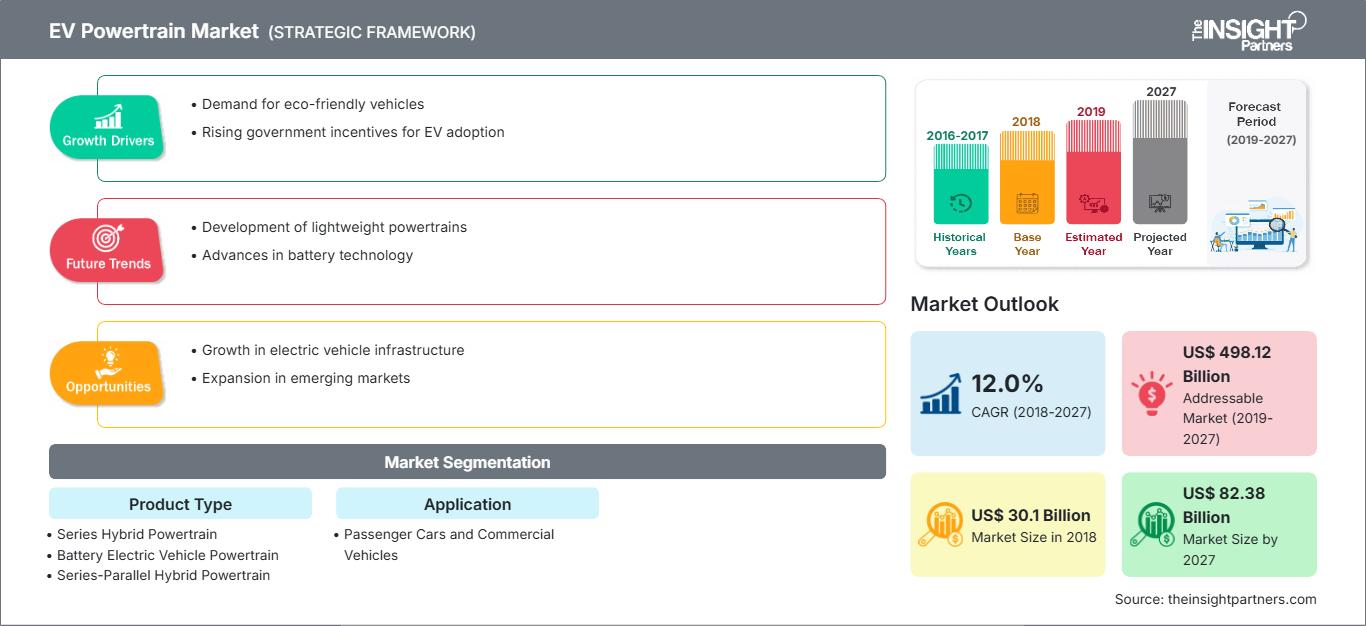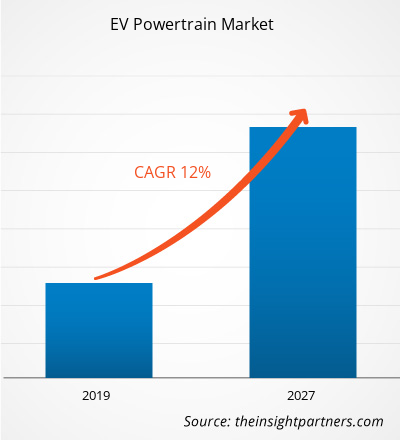Der Markt für Elektrofahrzeugantriebe belief sich im Jahr 2018 auf 30.095,5 Mio. USD und soll im Prognosezeitraum 2019–2027 mit einer durchschnittlichen jährlichen Wachstumsrate (CAGR) von 12,0 % wachsen und bis 2027 82.382,3 Mio. USD erreichen.
Geographisch ist der Markt für Elektrofahrzeugantriebe in Nordamerika, APAC, Europa und den Rest der Welt unterteilt. Der asiatisch-pazifische Raum war 2018 mit einem erheblichen Marktanteil führend auf dem Markt für Elektrofahrzeugantriebe und wird voraussichtlich auch im Prognosezeitraum 2019–2027 die am schnellsten wachsende Region sein. Darauf folgt Europa mit einigen gut entwickelten Ländern und einem starken Automobilsektor, der das Wachstum des Marktes für Elektrofahrzeugantriebe in der Region vorantreiben soll. In Nordamerika hingegen investieren die OEMs und Technologieanbieter kontinuierlich erhebliche Summen in die Entwicklung robuster Lösungen, was Fahrzeugkunden anzieht. China ist das Land mit der größten Produktion von Elektrofahrzeugen und hat weltweit die höchste Verbreitungsrate. Mehrere internationale Hersteller von Elektrofahrzeugen investieren in das Land und weiten ihre Produktionsstätten dort aus. Tesla beispielsweise investiert 2 Milliarden US-Dollar in ein neues Werk in Shanghai, China, für die Produktion der Limousine Model 3 und zukünftiger Fahrzeuge. Volkswagen verfolgt eine ähnliche Strategie und hat in den letzten sechs Jahren mehr als 10 Milliarden US-Dollar in China investiert. Europa ist der zweitgrößte Markt für Elektroantriebe. Nordamerika bleibt das drittgrößte geografische Segment im Markt für Elektroantriebe. In Nordamerika sind die wachsende Beliebtheit von Elektrofahrzeugen, die starke Automobilindustrie in Ländern wie den USA und Kanada sowie die Präsenz einer großen Zahl von Anbietern von Elektroantrieben einige der Hauptfaktoren, die das Wachstum des Marktes für Elektroantriebe in der Region voraussichtlich unterstützen werden.
Passen Sie diesen Bericht Ihren Anforderungen an
Sie erhalten kostenlos Anpassungen an jedem Bericht, einschließlich Teilen dieses Berichts oder einer Analyse auf Länderebene, eines Excel-Datenpakets sowie tolle Angebote und Rabatte für Start-ups und Universitäten.
Markt für Elektrofahrzeugantriebe: Strategische Einblicke

- Holen Sie sich die wichtigsten Markttrends aus diesem Bericht.Dieses KOSTENLOSE Beispiel umfasst Datenanalysen, die von Markttrends bis hin zu Schätzungen und Prognosen reichen.
Markteinblicke Regierungsinitiativen zur Einführung von Elektrofahrzeugantrieben
Sie erhalten kostenlos Anpassungen an jedem Bericht, einschließlich Teilen dieses Berichts oder einer Analyse auf Länderebene, eines Excel-Datenpakets sowie tolle Angebote und Rabatte für Start-ups und Universitäten.
Markt für Elektrofahrzeugantriebe: Strategische Einblicke

- Holen Sie sich die wichtigsten Markttrends aus diesem Bericht.Dieses KOSTENLOSE Beispiel umfasst Datenanalysen, die von Markttrends bis hin zu Schätzungen und Prognosen reichen.
Die globale Automobilindustrie erlebt einen deutlichen Wandel von herkömmlichen Fahrzeugen hin zu Elektrofahrzeugen. Regierungen in verschiedenen Ländern ergreifen Initiativen, um die Einführung von Elektrofahrzeugen voranzutreiben. Die kanadische Regierung investierte beispielsweise 182,5 Millionen US-Dollar in den Aufbau eines Schnellladenetzes für Elektrofahrzeuge. Im Dezember 2017 veröffentlichte die kanadische Bundesregierung außerdem ihre Greening Government Strategy, die darauf abzielt, die Treibhausgasemissionen bis 2050 um 80 % zu senken. Laut Clean Energy Canada investierte die kanadische Regierung 2017 zudem 1 Milliarde US-Dollar in die Produktion von Elektrofahrzeugen. Im Jahr 2019 waren aufgrund der steigenden Produktion und Nachfrage mehr als 40 Elektrofahrzeugmodelle auf dem kanadischen Markt erhältlich. Außerdem machen Elektrofahrzeuge 2,5 % aller in Kanada verkauften Fahrzeuge aus. Laut GOV.UK investierten die Behörden in Großbritannien im Juli 2019 zudem bis zu 100 Millionen US-Dollar in die Entwicklung von Elektrofahrzeugen der nächsten Generation. Daher arbeitet die Regierung auch mit Branchenführern zusammen, um die Entwicklung von Elektro- und Hybridfahrzeugen zu beschleunigen.
Technologische Entwicklung bei konventionellen Motoren
In den letzten Jahren hat es bei Autos erhebliche technologische Fortschritte gegeben, insbesondere bei der Entwicklung alternativer Technologien. Technologien wie elektrische Antriebssysteme werden voraussichtlich einen großen Anteil im Automobilsektor haben. Die Motoren entwickeln sich weiter, mit neuen Kraftstoffverbrauchs- und Emissionsstandards. Darüber hinaus wird die Elektrifizierung von Fahrzeugen als Fortschritt in der Automobiltechnologie angesehen.
Einblicke in Produkttypen
Der globale Markt für Elektrofahrzeug-Antriebe ist nach Typen unterteilt in serielle Hybridantriebe, batteriebetriebene Elektrofahrzeug-Antriebe, seriell-parallele Hybridantriebe, Mildhybridantriebe und parallele Hybridantriebe. Das Segment der batteriebetriebenen Elektrofahrzeug-Antriebe dominiert den Markt für Elektrofahrzeug-Antriebe stark und wird seine Dominanz voraussichtlich während des gesamten Prognosezeitraums ab 2019 beibehalten. 2027. Der batteriebetriebene Fahrzeugantrieb ist der beliebteste elektrische Antriebsstrang in der aktuellen EV-Antriebsstrangbranche.
Anwendungseinblicke
Der Markt für EV-Antriebsstränge ist nach Fahrzeugtyp weiter in Personenkraftwagen und Nutzfahrzeuge segmentiert. Das Personenkraftwagensegment des EV-Antriebsstrangmarktes dominierte den Fahrzeugtyp und wird seine Dominanz voraussichtlich während des Prognosezeitraums 2019 – 2027 beibehalten. Die steigende Nachfrage nach Personenkraftwagen weltweit ist auf das steigende verfügbare Einkommen der Bevölkerung in Industrie- und Entwicklungsländern zurückzuführen.
Marktinitiativen gelten als die am häufigsten verfolgte Strategie auf dem globalen EV-Antriebsstrangmarkt. Einige der jüngsten Marktinitiativen sind unten aufgeführt:
2019:Continental AG kündigte an, dass es mit der Massenproduktion seines ersten voll integrierten Achsantriebs in China beginnen werde. Die produzierten Motoren sollen in Fahrzeugen chinesischer und europäischer OEMs zum Einsatz kommen. 2019: Hydro-Québec gab bekannt, dass das Unternehmen 85 Millionen US-Dollar investiert hat, um das Wachstum von TM4, jetzt Dana TM4, zu sichern und seine Führungsposition im Bereich der elektrischen Antriebsstränge zu festigen. Seit Juni 2018 hält Hydro-Québec im Rahmen einer strategischen Partnerschaft mit Dana Incorporated einen Anteil von 45 % an der Tochtergesellschaft Dana TM4. 2019: Mahle hat einen voll integrierten modularen Hybridantrieb entwickelt, der für eine Vielzahl von Anwendungen eingesetzt werden kann. Der MAHLE Modular Hybrid Powertrain ist ein voll integrierter Plug-in-Hybridantrieb, der einen 2- oder 3-Zylinder-Turbobenzinmotor umfasst.
Elektrofahrzeug-AntriebsstrangRegionale Einblicke in den Markt für Elektrofahrzeugantriebe
Die Analysten von The Insight Partners haben die regionalen Trends und Faktoren, die den Markt für Elektrofahrzeugantriebe im Prognosezeitraum beeinflussen, ausführlich erläutert. In diesem Abschnitt werden auch die Marktsegmente und die geografische Lage in Nordamerika, Europa, im asiatisch-pazifischen Raum, im Nahen Osten und Afrika sowie in Süd- und Mittelamerika erörtert.
Umfang des Marktberichts zum Antriebsstrang von Elektrofahrzeugen
| Berichtsattribut | Einzelheiten |
|---|---|
| Marktgröße in 2018 | US$ 30.1 Billion |
| Marktgröße nach 2027 | US$ 82.38 Billion |
| Globale CAGR (2018 - 2027) | 12.0% |
| Historische Daten | 2016-2017 |
| Prognosezeitraum | 2019-2027 |
| Abgedeckte Segmente |
By Produkttyp
|
| Abgedeckte Regionen und Länder | Nordamerika
|
| Marktführer und wichtige Unternehmensprofile |
|
Dichte der Marktteilnehmer für Elektrofahrzeugantriebe: Auswirkungen auf die Geschäftsdynamik verstehen
Der Markt für Elektrofahrzeugantriebe wächst rasant. Die steigende Nachfrage der Endverbraucher ist auf Faktoren wie veränderte Verbraucherpräferenzen, technologische Fortschritte und ein stärkeres Bewusstsein für die Produktvorteile zurückzuführen. Mit der steigenden Nachfrage erweitern Unternehmen ihr Angebot, entwickeln Innovationen, um den Bedürfnissen der Verbraucher gerecht zu werden, und nutzen neue Trends, was das Marktwachstum weiter ankurbelt.

- Holen Sie sich die Markt für Elektrofahrzeugantriebe Übersicht der wichtigsten Akteure
- Serieller Hybridantrieb
- Batteriebetriebener Elektrofahrzeugantrieb
- Seriell-paralleler Hybridantrieb
- Mild-Hybridantrieb
- Paralleler Hybridantrieb
Globaler Markt für EV-Antriebe – nach Anwendung
- Pkw
- Nutzfahrzeuge
Globaler Markt für EV-Antriebe – nach Geografie
Nord Amerika
- USA
- Kanada
- Mexiko
Europa
- Frankreich
- Deutschland
- Großbritannien
- Schweden
- Niederlande
- Slowakei
- Restliches Europa
Asien-Pazifik (APAC)
- China
- Japan
- Indien
- Südkorea
Rest der Welt (ROW)
Globaler Markt für Elektrofahrzeug-Antriebsstränge – Unternehmensprofile
- Continental AG
- Robert Bosch GmbH
- Cummins, Inc.
- Maxim Integrated Products, Inc.
- Magna International Inc.
- Tata Elxsi
- Dana Limited
- Valeo SA
- Mahle GmbH
- ZF Friedrichshafen AG
- Historische Analyse (2 Jahre), Basisjahr, Prognose (7 Jahre) mit CAGR
- PEST- und SWOT-Analyse
- Marktgröße Wert/Volumen – Global, Regional, Land
- Branchen- und Wettbewerbslandschaft
- Excel-Datensatz
Aktuelle Berichte
Erfahrungsberichte
Grund zum Kauf
- Fundierte Entscheidungsfindung
- Marktdynamik verstehen
- Wettbewerbsanalyse
- Kundeneinblicke
- Marktprognosen
- Risikominimierung
- Strategische Planung
- Investitionsbegründung
- Identifizierung neuer Märkte
- Verbesserung von Marketingstrategien
- Steigerung der Betriebseffizienz
- Anpassung an regulatorische Trends




















 Kostenlose Probe anfordern für - Markt für Elektrofahrzeugantriebe
Kostenlose Probe anfordern für - Markt für Elektrofahrzeugantriebe